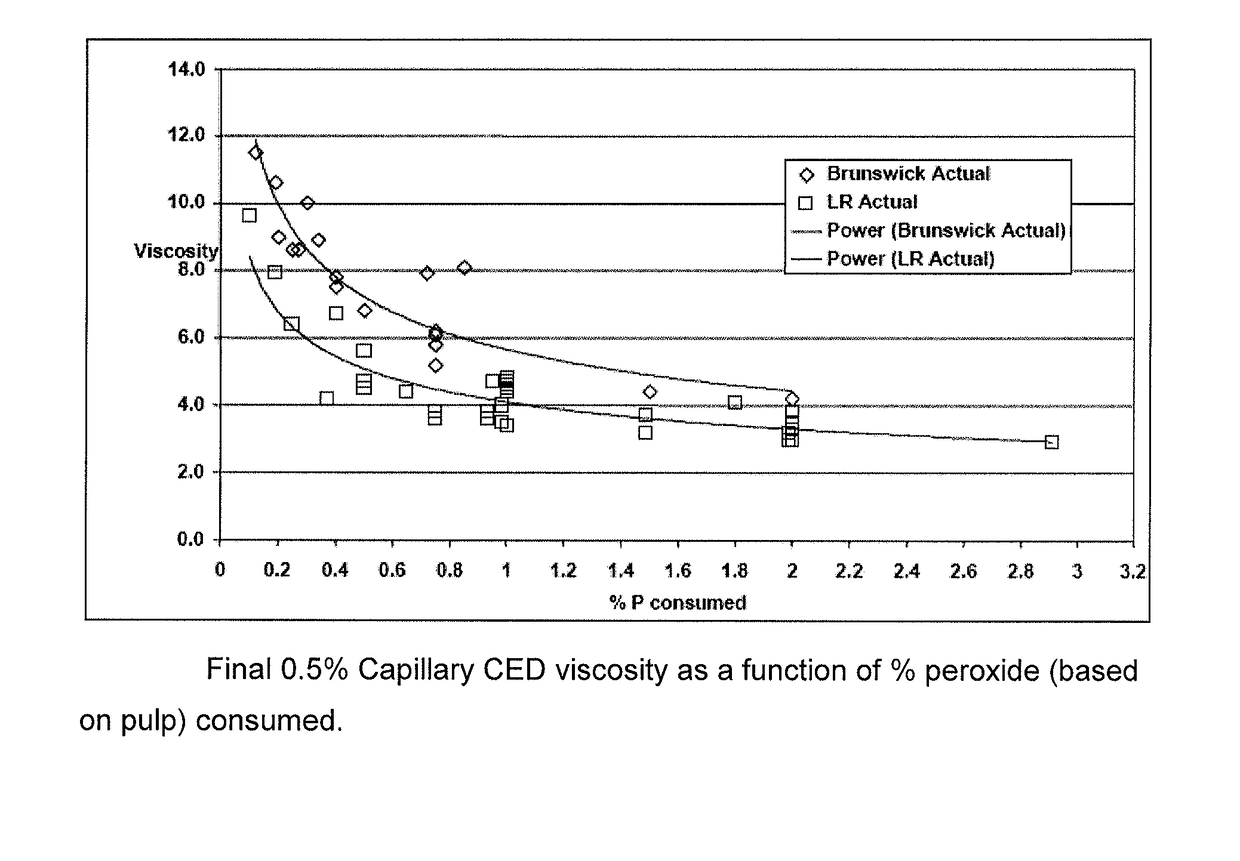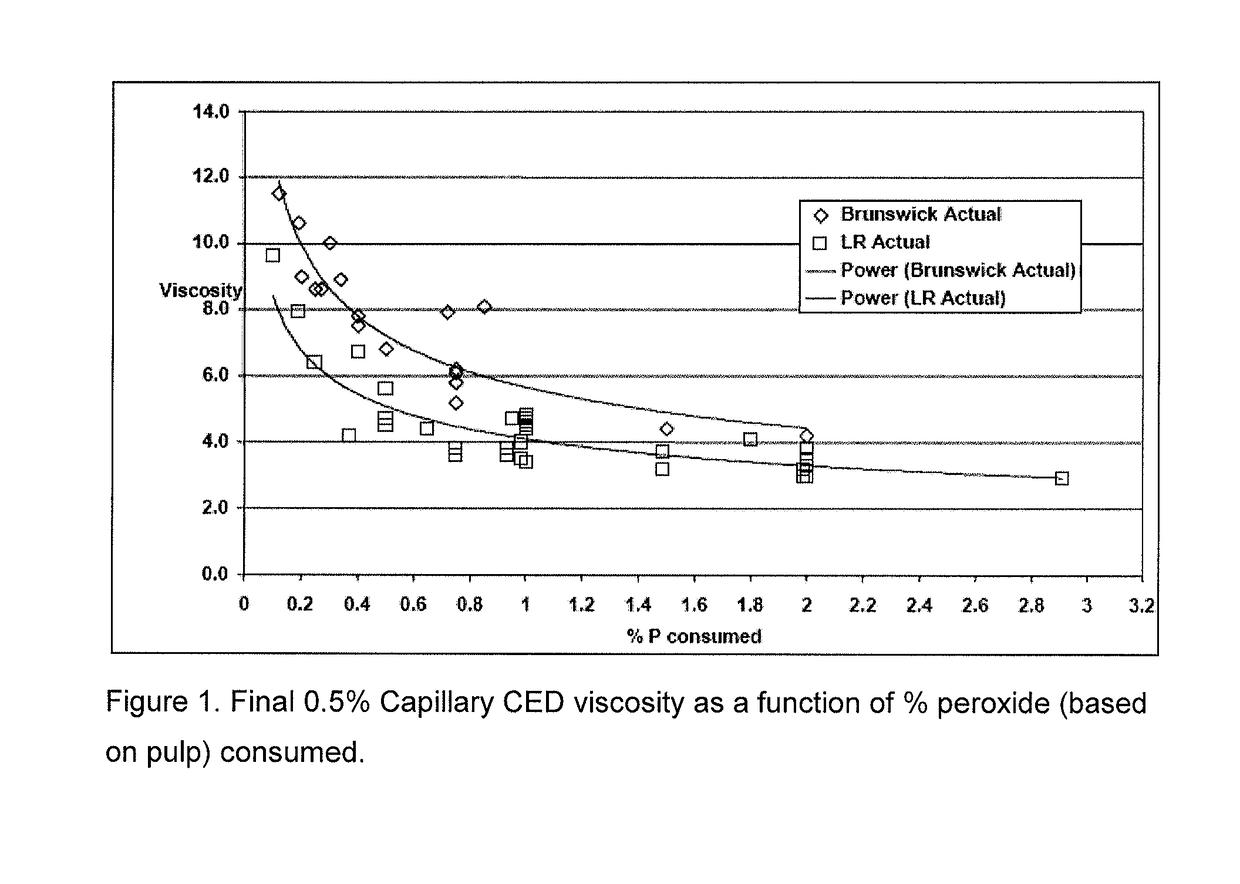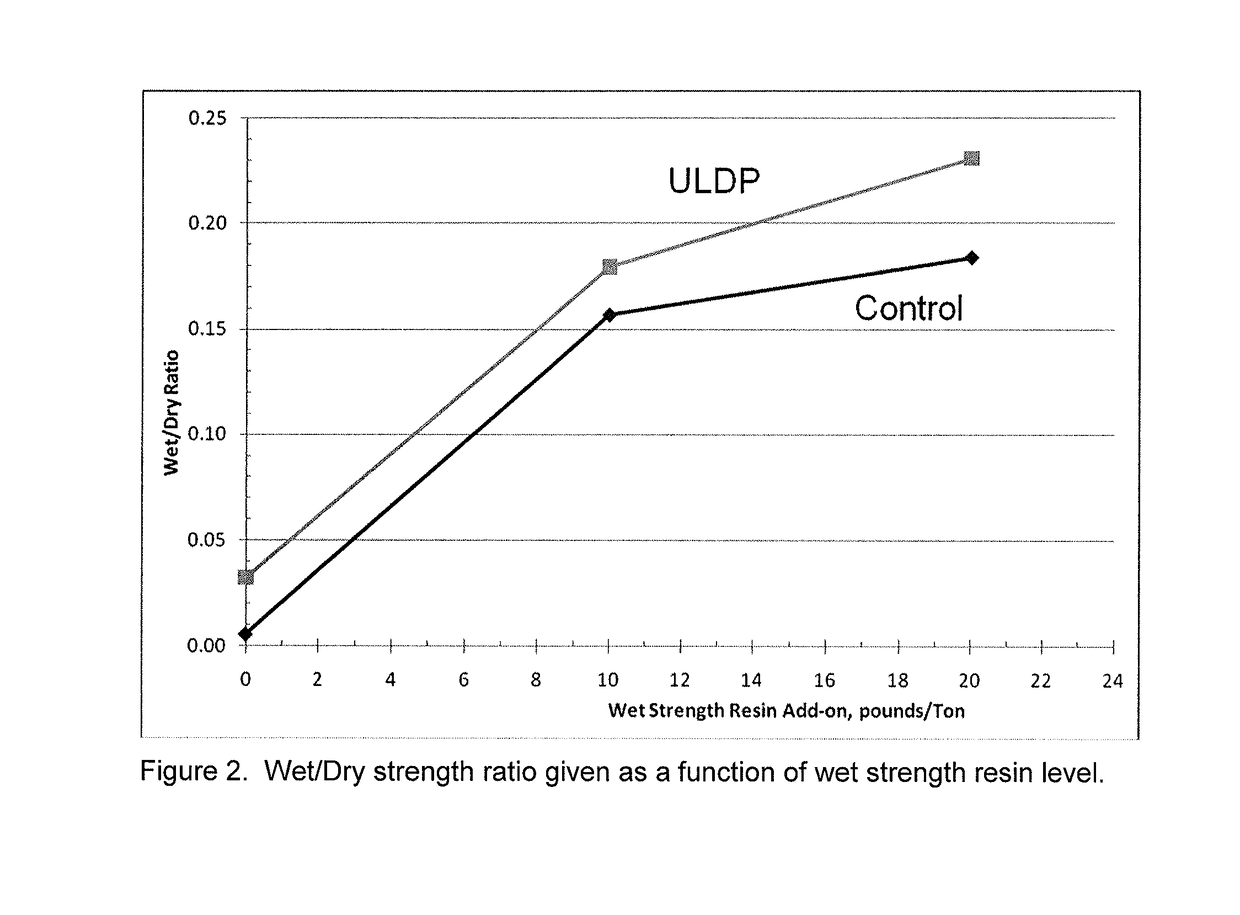It is known that, certain oxidation conditions may degrade the cellulose chains themselves, for example by cleaving the glycosidic rings in the cellulose chain, resulting in
depolymerization.
When cellulose is degraded, such as by depolymerizing and / or significantly reducing the fiber length and / or the
fiber strength, it may be difficult to process and / or may be unsuitable for many downstream applications.
In traditional cellulose oxidation methods, it may be difficult to control or limit the degradation of the cellulose when
aldehyde groups are present on the cellulose.
Previous attempts at resolving these issues have included the use of multi-step oxidation processes, for instance site-specifically modifying certain carbonyl groups in one step and oxidizing other hydroxyl groups in another step, and / or providing mediating agents and / or protecting agents, all of which may impart extra cost and by-products to a cellulose
oxidation process.
Thus, it would not have been expected that Fenton's
reagent could be used in a
kraft process without extensive degradation of the fibers, for example with an accompanying loss in fiber length, at acidic conditions.
However, additional drawbacks may exist to using Fenton's
reagent under alkaline conditions.
In addition to the difficulties in controlling the
chemical structure of cellulose oxidation products, and the degradation of those products, it is known that the method of oxidation may affect other properties, including chemical and physical properties and / or impurities in the final products.
Ultimately, the method of oxidation may
impact the ability to process the cellulose product for industrial or other applications.
Generally, while it is known that certain bleaching sequences may have advantages over others in a
kraft process, the reasons behind any advantages are less well understood.
For instance, the prior art does not disclose any preference for a later stage oxidation over an earlier stage oxidation.
In addition, with respect to brightness in a kraft bleaching process, it is known that metals, in particular transition metals naturally present in the pulp starting material, are detrimental to the brightness of the product.
Thus, because there is emphasis on removing the metals naturally present in the pulp, a person of skill in the art would generally not add any metals to a bleaching sequence as that would compound the difficulties in achieving a brighter product.
With respect to iron, moreover, addition of this material to a pulp leads to significant discoloration, akin to the discoloration present when, for example, burning paper.
Thus, it has been expected that upon discoloring a wood pulp with added iron, the pulp would suffer a permanent loss in brightness that could not be recovered with additional bleaching.
Thus, while is known that iron or
copper and
peroxide can inexpensively oxidize cellulose, heretofore they have not been employed in
pulp bleaching processes in a manner that achieves a comparable brightness to a
standard sequence not employing an iron or
copper oxidation step.
Typically, removing iron from cellulose is difficult and costly, and requires additional
processing steps.
For instance, iron may lead to discoloration of the final product and / or may be unsuitable for applications in which the final product is in contact with the
skin, such as in diapers and wound dressings.
Thus, the use of iron in a kraft bleaching process would be expected to suffer from a number of drawbacks.
Heretofore, oxidation treatment of kraft fiber to improve functionality has often been limited to oxidation treatment after the fiber was bleached.
Moreover, known processes for rendering a fiber more aldehydic also cause a concomitant loss in fiber brightness or quality.
Furthermore, known processes that result in enhanced aldehydic functionality of the fiber also result in a loss of carboxylic functionality.
However, standard kraft fiber has limited applicability in downstream applications, such as cellulose derivative production, due to the
chemical structure of the cellulose resulting from standard kraft pulping and bleaching.
In general, standard kraft fiber contains too much residual hemi-cellulose and other naturally occurring materials that may interfere with the subsequent physical and / or
chemical modification of the fiber.
Moreover, standard kraft fiber has limited chemical functionality, and is generally rigid and not highly compressible.
Heretofore, modification of kraft fiber by oxidation to improve its
odor control capability invariably came with an undesirable decrease in brightness.
Ultra-thin product designs require lower fiber weight and can suffer from a loss of product integrity if the fiber used is too short.
Chemical modification of kraft fiber can result in loss of fiber length making it unacceptable for use in certain types of products, e.g., ultra-thin products.
More specifically, kraft fiber treated to improve
aldehyde functionality, which is associated with improved
odor control, may suffer from a loss of fiber length during
chemical modification making it unsuitable for use in ultra-thin product designs.
Traditionally, cellulose sources that were useful in the production of absorbent products or tissue were not also useful in the production of downstream
cellulose derivatives, such as cellulose ethers and cellulose esters.
The production of low
viscosity cellulose derivatives from high
viscosity cellulose raw materials, such as standard kraft fiber, required additional manufacturing steps that would add significant cost while imparting unwanted by-products and reducing the overall quality of the cellulose derivative.
However, production of
cotton linters and
sulfite fiber with a high
degree of polymerization and / or
viscosity is expensive due to the cost of the starting material, in the case of cotton; the
high energy, chemical, and environmental costs of pulping and bleaching, in the case of
sulfite pulps; and the extensive purifying processes required, which applies in both cases.
In addition to the high cost, there is a dwindling supply of sulfite pulps available to the market.
Therefore, these fibers are very expensive, and have limited applicability in pulp and paper applications, for example, where higher DP or higher viscosity pulps may be required.
For cellulose derivative manufacturers these pulps constitute a significant portion of their overall manufacturing cost.
The use of kraft fiber in
microcrystalline cellulose production, without the addition of extensive post-bleaching
processing steps, has heretofore been limited.
The
dissolution of the non-crystalline segments from standard kraft fiber generally degrades the fiber to an extent that renders it unsuitable for most applications because of at least one of 1) remaining impurities; 2) a lack of sufficiently long crystalline segments; or 3) it results in a
cellulose fiber having too high a
degree of polymerization, typically in the range of 200 to 400, to make it useful in the production of
microcrystalline cellulose.
 Login to View More
Login to View More 


